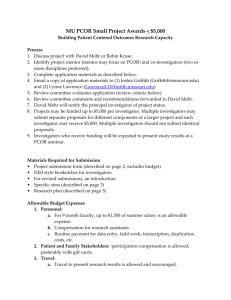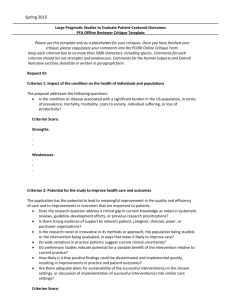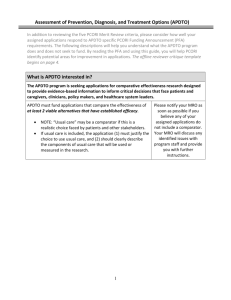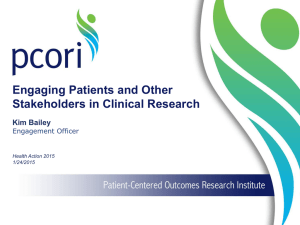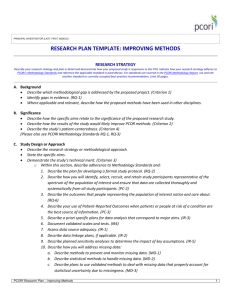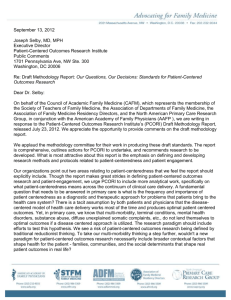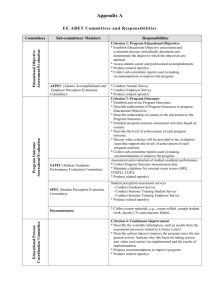PCORI-Methods-Reviewer-Critique-Offline-Template
advertisement
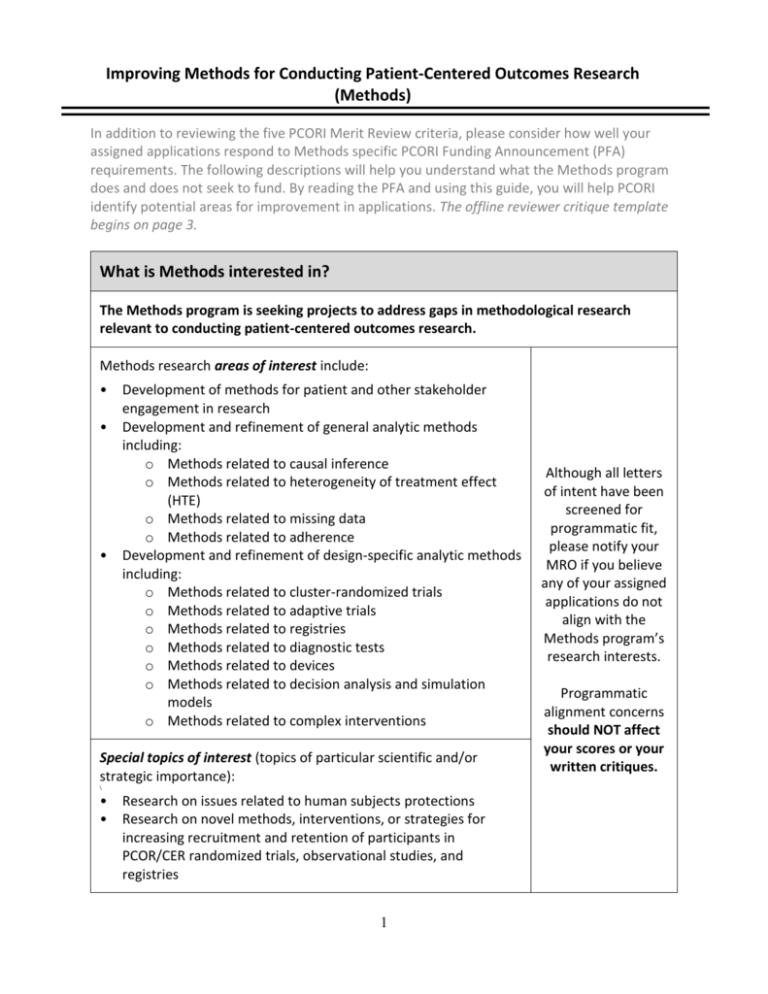
Improving Methods for Conducting Patient-Centered Outcomes Research (Methods) In addition to reviewing the five PCORI Merit Review criteria, please consider how well your assigned applications respond to Methods specific PCORI Funding Announcement (PFA) requirements. The following descriptions will help you understand what the Methods program does and does not seek to fund. By reading the PFA and using this guide, you will help PCORI identify potential areas for improvement in applications. The offline reviewer critique template begins on page 3. What is Methods interested in? The Methods program is seeking projects to address gaps in methodological research relevant to conducting patient-centered outcomes research. Methods research areas of interest include: • • • Development of methods for patient and other stakeholder engagement in research Development and refinement of general analytic methods including: o Methods related to causal inference o Methods related to heterogeneity of treatment effect (HTE) o Methods related to missing data o Methods related to adherence Development and refinement of design-specific analytic methods including: o Methods related to cluster-randomized trials o Methods related to adaptive trials o Methods related to registries o Methods related to diagnostic tests o Methods related to devices o Methods related to decision analysis and simulation models o Methods related to complex interventions Special topics of interest (topics of particular scientific and/or strategic importance): \ • • Research on issues related to human subjects protections Research on novel methods, interventions, or strategies for increasing recruitment and retention of participants in PCOR/CER randomized trials, observational studies, and registries 1 Although all letters of intent have been screened for programmatic fit, please notify your MRO if you believe any of your assigned applications do not align with the Methods program’s research interests. Programmatic alignment concerns should NOT affect your scores or your written critiques. • Development of methods to support data research networks o Methods to improve distributed analyses in data research networks o Methods to obtain longitudinal and complete data in data research networks What is Methods NOT interested in? PCORI cannot fund applications that measure cost effectiveness. o Research cannot conduct a formal cost-effectiveness analysis in the form of dollar-cost per quality-adjusted life year. o Research cannot measure the relative costs of care of two or more alternative approaches as the primary criterion for choosing the preferred alternative. Methods cannot fund applications that develop practice guidelines, coverage recommendations, payment or policy recommendations. Topics related to methods for the following are considered nonresponsive: o Methods related to generating, selecting, and prioritizing topics for research o Conducting systematic review in patient-centered outcomes research/comparative effectiveness research Please notify your MRO if an application includes a formal costeffectiveness analysis or proposes to develop practice guidelines or recommendations. Reminder of important required application component The proposed research must adhere to all relevant PCORI Methodology Standards (most relevant to assessment of Criterion 3). The following methodology standards are particularly important: Address a true gap in evidence in their application (RQ-1) Identify the comparators and explain why they were selected (RQ-5) Provide a rationale and define “usual care,” if it is proposed (RQ-5) Show that the outcomes chosen are relevant to patients and end users (RQ-5) Show that study participants represent target populations and are properly recruited, enrolled, and retained (PC-2) Describe rigorous data analysis plans (IR-1, IR-3) Address heterogeneity of treatment effects and state the aims of HTE analysis (HT-1) Describe their plan and statistical methods for handling missing data in their project (MD-1, MD-2) 2 Please address in your written critique how well the application has described this required component. Improving Methods for Conducting PCOR PFA Offline Reviewer Critique Template Please use this template only as a placeholder for your critiques. Once you have finished your critique, please copy/paste your comments into the PCORI Online Critique Form. Keep each criterion box to no more than 5000 characters, including spaces. Comments for each criterion should list out strengths and weaknesses. Comments for the Human Subjects and Overall Narrative sections should be written in paragraph form. Request ID: Criterion 1: Identifies evidence gaps noted in the PCORI Methodology Report or other comparable sources Refers to whether the proposed study explicitly identifies gaps noted in the report or other sources. The proposal addresses the following questions: Does the research question identify a critical gap in current methodological understanding as noted in the Methodology Committee Report or in other sources? Which particular gap(s)? *Please note that proposals that do not explicitly identify a gap noted in the Methodology Committee Report will still be considered. However, applicants should provide strong support for their claims that their proposal does address a current gap in PCOR methods. Criterion Score: Strengths: Weaknesses: - Criterion 2: Potential for the study to improve PCOR methods Refers to the potential of the proposed methodological investigation and its results to change methodological practices in ways that improve PCOR and ultimately support the decisions made by patients and their clinicians. The proposal addresses the following questions: Do existing methods weaken the validity of PCOR studies? Would improved methods increase the validity of PCOR findings? How often would these methods be used, and how many PCOR studies would benefit from these improved methods? Is the proposed approach feasible and likely to result in new standards or in the improvement of existing standards? 3 Criterion Score: Strengths: Weaknesses: - Criterion 3: Technical Merit Refers to the technical merit of the proposal. The proposal addresses the following questions: Is there a clear research plan with rigorous methods that demonstrates adherence to PCORI’s Methodology Standards? Does the proposal delineate a clear conceptual framework/theory/model that anchors the background literature and informs the design, key variables, and relationships being tested? Do the study methods reflect state-of-the-art thinking and practice in the methodological area, so that results are likely to be accepted and heeded? Is the project timeline realistic, including specific scientific and engagement milestones? Does the research team have the necessary expertise to conduct the project? Are the organizational structure and the described resources appropriate to carry out the project? Will the proposed methods help support the inclusion and study of diverse populations with respect to age, gender, race, ethnicity, geography, or clinical status, or, alternatively, do the methods support the inclusion of previously understudied populations in PCOR? Criterion Score: Strengths: Weaknesses: - Criterion 4: Patient-Centeredness The proposal demonstrates patient-centeredness at every stage of the research. It addresses the following questions: Is the research focused on questions that affect outcomes of interest to patients and their caregivers? Does the research address one or more of the key questions mentioned in PCORI’s definition of patient-centered outcomes research? 4 Criterion Score: Strengths: Weaknesses: - Criterion 5: Patient and Stakeholder Engagement The proposal demonstrates that people representing the population of interest and other relevant stakeholders are engaged in ways that are appropriate and necessary in a given research context. It addresses the following questions: Are patients and other stakeholders engaged in: o Formulating research questions o Defining essential characteristics of study participants, comparators, and outcomes o Monitoring study conduct and progress o Designing/suggesting plans for dissemination and implementation activities Are the roles and the decision making authority of all research partners clearly stated? Does the proposal demonstrate the principles of reciprocal relationships, co-learning, partnership, trust, transparency, and honesty? If engagement is not applicable to the proposed research, does the application adequately justify why it is not? Criterion Score: Strengths: Weaknesses: - 5 Protection of Human Subjects: Does the application have acceptable risks and/or adequate protections for human subjects? (Yes/No) Comments: Overall Narrative: Overall Score: 6
